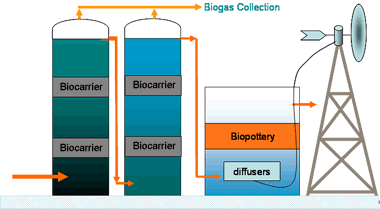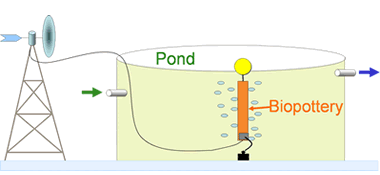Animal operations are recognized as the biggest contributor of pollutants to rivers, lakes, and oceans in the USA. Control of pollution from animal operations is a challenge because the animal wastewater has high organic content and many different pollutants, making it difficult to treat by conventional methods. Current methods are costly and not favorably accepted by farmers.
University of Hawaii scientists have developed an innovative system that provides clean water, clean air, and clean energy using a compact and cost-effective design. This so-called 5-C's system has been successfully operated at a dairy farm in Hawaii. This system uses two innovative technologies, the anaerobic biocarrier reactor and the aerobic biopottery reactor.

Anaerobic Biocarrier Reactor
The fat-lipid content of dairy wastewater causes most conventional anaerobic reactors to perform poorly. To solve this problem, we developed an innovative reactor, the biocarrier reactor. As shown in the diagram, each anaerobic biocarrier reactor has two layers of plastic nests holding highly concentrated and activated anaerobic bacteria. When wastewater passes through the nests, bacteria break down pollutants, converting them to biogas and making the water clean. It can be operated in 18–40°C ambient temperature, with more than 75% pollutant removal at a pollutant loading rate of 15 kg/m3/day, and it recovers biogas with 70% methane. The anaerobic biocarrier reactor is the fastest anaerobic reactor for dairy wastewater treatment in the world.
 |
Figure 1: UH patent-pending technology, the anaerobic biocarrier reactors (left two) treat dairy wastewater four times faster than conventional methods. It can be operated at 18–40°C ambient temperature with 75% pollutant removal at a pollutant loading rate of 15 kg/m3/day, and it recovers biogas with 70% methane. The right open top reactor is the aerobic biopottery reactor.
|
Aerobic Biopottery Reactor
The biopottery reactor receives the effluent from a biocarrier reactor. It is an open-top tank with a layer of highly porous and shrinkable pottery inside. This pottery naturally selects and immobilizes aerobic bacteria for wastewater treatment. Once active bacteria become resident in the pottery, “biopottery” is formed. The bacteria in the biopottery “eat” 50% of the pollutants left by the previous anaerobic treatment and make the water cleaner. Instead of using electricity, a windmill pumps air for the bacterial activity. The treated water exiting the biopottery reactor is clean enough to be reused for washing floors or irrigation.
The odor from animal manure is held in the tanks until oxidized in the aerobic reactor. The system, therefore, keeps the air clean in the immediate environment.
The systems, including the two-stage biocarrier reactors and an aerobic biopottery reactor, have been operated for seven month without significant maintenance problems. The system treats wastewater in 16–20 hours that conventional systems need at least two days to treat; the system is stable and achieves 91.6% total COD removal. The tanks used to treat the same amount of wastewater are smaller than conventional methods, achieving a compact installation.
 |
Figure 2: The biopottery-windmill pond cleanup system integrating biotech and windmill aeration technology cleans water from animal production systems for reuse. This easy-to-install system is a cost-effective, energy-efficient approach to treat polluted lakes and rivers in situ.
|
Biopottery- Windmill Pond Cleanup System
The biopottery technology was also integrated with a windmill aeration device for pond treatment improvement. Three cages, each of which held 25 kg biopottery materials, were installed and suspended by a floating air ball. At the bottom of the cage an air diffuser was installed and connected to the windmill air compressor through an air hose. The biopottery cage randomly moves within a 5-meter circle when wind blows over the pond surface. The three systems were placed at the pond inlet, the middle of pond, and 10 meters in front of the pond outlet. A diagram shows the biopottery-windmill structure in Figure 2 .
The integration of biotechnology and wind energy will help farmers treat and reuse the waste, control runoff of pollutants, and make the dairy industry sustainable.
This project supported by U.S. EPA Clean Water Act Section 319(h) grants through Hawaii Dept. of Health Clean Water Branch.
|